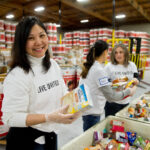Search
Real Cost Measure: New United Way study finds over 1 in 4 Bay Area households struggle to meet basic needs
June 6, 2023
New United Way study finds over 1 in 4 Bay Area households struggle to meet basic needs
New data reveals the true cost of living in the Bay Area – too many working families don’t earn enough to meet a decent standard of living based on 2021 census data

FOR IMMEDIATE RELEASE
MEDIA CONTACT:
Paulina Campos
(650) 455-9928
paulina@emccommunications.com
June 6, 2023, San Francisco, Calif. – Over one in four San Francisco Bay Area working families struggled to cover their daily needs in 2021, according to a new study released by United Ways of California. The Real Cost Measure in California 2023 factors the costs of housing, health care, child care, transportation and other basic needs that are not captured by the outdated federal poverty measurement to reveal the true cost of a decent standard of living in California.
“In the Bay Area, more than a quarter of households worked for wages that did not cover their basic needs in 2021. That’s more than 650,000 of our neighbors who are working, yet still struggling financially, particularly Latinx and Black families,” said Kevin Zwick, CEO of United Way Bay Area. “We know that California has the resources to fix this. From 1984 to 2021, California gross domestic product grew by 173%, but median household earnings only rose 4%. It’s clear that the state’s economic gains are not reaching working families as it should.”
The Real Cost Measure website includes findings for each California county, interactive maps, and a calculator feature which allows individuals to calculate how much a household in their specific area needs to earn to make ends meet.
“The Real Cost Measure in California 2023 shows that many more California working families struggle to meet living costs than official estimates, and identifies significant gaps between what it costs for families and their children to live with dignity and what they actually earn,” said Peter Manzo, President & CEO of United Ways of California. “This Real Cost Measure should be the yardstick by which we set our statewide priorities, and this study is a wake-up call to elected officials, civic leaders, the business sector, and community members that much more needs to be done to help families thrive.”
The study’s other key findings for the Bay Area region include:
❖ Struggling Households Work: Of the estimated 654,337 households in the Bay Area that fall below the Real Cost Measure, 97% have at least one working adult.
❖ Housing Burden: Nearly 4 in 10 households in the region (35%) pay at least 30% of their income on housing, which is considered a dangerous threshold by affordable housing advocates.
❖ Child care costs are the second-highest, only behind housing costs:
In the Bay Area, the annual cost of child care for a family with two adults, one
preschooler and one school-aged child can reach $22,764.
❖ Almost half of young children live in struggling households: 40% of households in the Bay Area with children younger than six-years-old fall below the Real Cost Measure.
❖ Households of all races struggle, but is highest for Latinx and Black families:
Around 215,559 Latinx households (or 49% of them) are estimated to not earn enough to get by, compared to around 220,147 white households (19%); 151,959 Asian American households (23%); and 60,691 Black households (45%).
❖ Less Education Results in Greater Struggles: Nearly 7 in 10 households without a high school diploma or equivalent (69%) fall below the Real Cost Measure, compared to those with a high school diploma (51%), those with at least some college education (37%), and those with a bachelor’s degree or further (14%).
❖ Single Mothers: 6 in 10 households led by single mothers (64%) fall below the Real Cost Measure.
❖ Foreign-Born Households Have More Trouble Meeting Basic Needs: 40% percent of households in California that are led by a person born outside the U.S. are below the Real Cost Measure. Meanwhile, 24% of households led by a person born in the U.S. earn income below the Real Cost Measure.
The federal government uses an outdated formula for calculating poverty — one that fails to take into account how much rent, transportation, healthcare, childcare, and other basic needs cost in California. The Real Cost Measure reveals a more accurate poverty calculation by capturing these costs as well as taking into account demographic factors including geographic, race, gender, nativity, occupational type, marital status, educational attainment, employment status, housing type, and more.
Learn more about the Real Cost Measure study
View local Bay Area Real Cost Data
About United Way Bay Area
United Way Bay Area (UWBA) mobilizes the Bay Area to assist people living in poverty and to dismantle the root causes of poverty. One of the most respected and highly effective philanthropic organizations fighting poverty, UWBA supports workers and students seeking employment and better careers, helps families struggling to meet basic needs, supports our neighbors toward achieving their financial stability goals, and advocates for housing justice for all Bay Area residents. Learn more at uwba.org.


